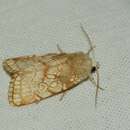Biology
provided by Arkive
This moth is single-brooded, and adults fly between late June and July. The caterpillars are active at night between April and early June, and spend the day concealed in a tent of leaves held together with silk (2). The overwintering stage is the egg (2).
Conservation
provided by Arkive
A Species Action Plan has been produced for the Heart Moth under the UK BAP (Biodiversity Action Plan). This plan aims to maintain all known populations of this species, with enhancement of the populations by 2010 (1). These aims may be achieved through appropriate habitat management and creation, agri-environment schemes, and by linking fragmented habitat patches together (1). In addition, research into the detailed habitat requirements of this species in order to guide suitable habitat management has been underway for a couple of years, directed by Butterfly Conservation (5).
Description
provided by Arkive
The Heart Moth is pale in colour with light brown patterning and off-white hind-wings. It takes its common name from the single heart-shaped mark on each forewing (3). The caterpillar has a black back with three white lines, and has a brown underside (4).
Habitat
provided by Arkive
Inhabits parkland and open woodland. The caterpillars feed preferentially on mature pedunculate oak (Quercus robur) (1).
Range
provided by Arkive
The only sizable populations at present occur in Surrey, but this moth also persists in the Windsor Forest area in Berkshire, Northamptonshire, and there has been a recent record from the north-west of Kent, the first record here for around 80 years (5). It is known to have become locally extinct in Essex, Buckinghamshire, Middlesex, Hertfordshire and Hampshire. Despite being known from most European countries, it is extinct, rare or local in many areas (1).
Status
provided by Arkive
Classified as Rare in Great Britain (1).
Threats
provided by Arkive
The widespread felling of mature oaks preferred by the caterpillars is thought to have been of major significance in the decline (1).
Dicycla oo
provided by wikipedia EN
The heart moth (Dicycla oo) is a species of moth of the family Noctuidae. It is found locally in Europe. It is also present in Turkey, Transcaucasia, the Caucasus, Israel, Iran and Iraq.
Technical description and variation
D. oo L. (47 k). Forewing pale yellow, slightly dusted with ferruginous; veins and lines and outlines of stigmata ferruginous: fringe mottled with the same colour; hindwing yellowish white, washed with grey and darker before termen; in the form ferruginago Hbn. the base and the space between outer and submarginal lines are dark: in the ab. renago Haw. (47 k) there is a ferruginous fascia before inner line and between median shade and submarginal line, united along inner margin; sulphurea Stgr. is wholly sulphur yellow: the ferruginous scales are sometimes replaced by grey = ab. griseago Schultz. Larva black-brown, clotted with white; lines white; the dorsal irregularly blotched: the subdorsal slender; the spiracular broad. [2] The wingspan is 32–39 mm.
Biology
Adults are on wing from June to August.
The larvae feed on united leaves of Quercus species. Larvae can be found from May to June. The species overwinters as an egg.
References
-
^ Fauna Europaea
-
^ Warren. W. in Seitz, A. Ed., 1914 Die Großschmetterlinge der Erde, Verlag Alfred Kernen, Stuttgart Band 3: Abt. 1, Die Großschmetterlinge des palaearktischen Faunengebietes, Die palaearktischen eulenartigen Nachtfalter, 1914
 This article incorporates text from this source, which is in the public domain.
This article incorporates text from this source, which is in the public domain.

- license
- cc-by-sa-3.0
- copyright
- Wikipedia authors and editors
Dicycla oo: Brief Summary
provided by wikipedia EN
The heart moth (Dicycla oo) is a species of moth of the family Noctuidae. It is found locally in Europe. It is also present in Turkey, Transcaucasia, the Caucasus, Israel, Iran and Iraq.
- license
- cc-by-sa-3.0
- copyright
- Wikipedia authors and editors

